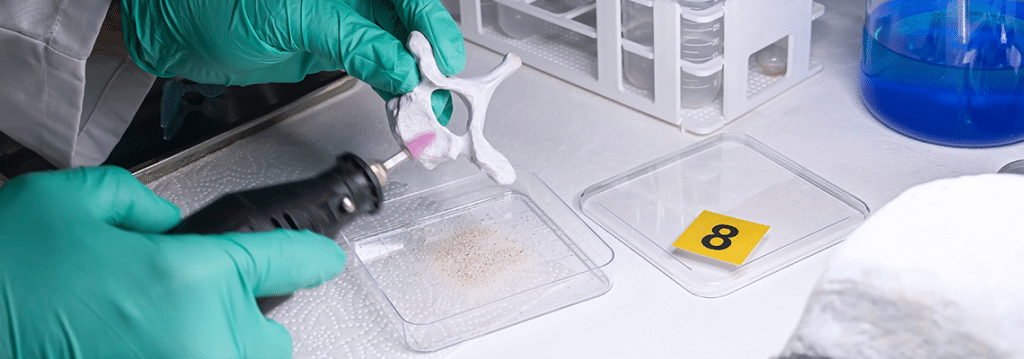
A New Method for DNA Extraction from Bone Samples
May 1, 2022
Forensic laboratories have long struggled to find the best practice for obtaining sufficient DNA from bone specimens. Any new protocol must overcome the extraction efficiency hurdle while also limiting the presence of PCR inhibitors, thus permitting the generation of utilizable STR profiles from this challenging medium. This blog post elaborates on a presentation by InnoGenomics at the 2022 American Academy of Forensic Science meeting, where we offered just such a solution for DNA extraction from bone.
Although commercial products and methodologies are available, the extraction of bone for forensic workflows presents challenges. Analysts struggle with low template DNA, high degradation, and genetic material that is generally inhibited, which ultimately limits STR profile generation for identification purposes.
“When it comes to wet bench work in forensic labs, time and resources are critical commodities,” says Mah-ro Khan, MSFS, InnoGenomics’ Associate Scientist. “Bone samples are common in forensic investigations, especially in victim identification. So, getting a sufficient profile often starts with isolating DNA from what has long been a challenging matrix.”
InnoGenomics’ InnoXtract system was originally validated for the extraction of DNA from another challenging specimen—rootless hair shafts. Now, we have demonstrated that InnoXtract offers an incredibly efficient methodology for bone specimens.
InnoXtract utilizes an optimized digestion protocol and single-tube nanoparticle magnetic bead purification system. This provides a more efficient DNA extraction than comparable commercial methods.
Validation
At AAFS 2022, Khan explained that InnoXtract’s value stems from its efficiency and sensitivity. In our research, InnoXtract yielded higher or comparable levels of both short- and long-target DNA compared to all other methods tested for DNA bone extractions. InnoXtract can also recover more short, fragmented DNA compared to other methods. This can improve NGS results for highly degraded bone samples.
Sensitivity study results demonstrated that the InnoXtract system consistently performed with high efficiency, permitting recoveries of degraded DNA samples at a quantity as low as 5.99 picograms (pg). InnoXtract’s magnetic bead methodology resulted in approximately 80% recovery of degraded DNA from inputs of 264 pg and 6 pg.
These impressive results show the high recovery percentages offered by the kit in obtaining DNA from a challenging matrix like bone. In addition, the system proved to be repeatable and reproducible, with comparable yields for samples across a nine-day period and amongst different operators.
Comparison Studies
Following development of the InnoXtract protocol, we sought to compare the performance of our product against commonly utilized extraction kits, such as Thermo Fisher’s PrepFiler BTA and Qiagen’s DNA Investigator.
InnoXtract generated better yield of both short and long DNA across four of the five bone samples tested. Quantification data additionally pointed toward a significantly higher yield of environmentally degraded or compromised bone, such as a burned bone and bone that underwent over two years of surface decomposition. In some bone comparisons, InnoXtract was able to produce 2- to 4-fold more short target DNA yields compared to other commercial kits.
InnoXtract’s validation and performance, compared to commonly used commercial kits, displays its efficiency with DNA extraction and purification from a challenging matrix like bone, as well as provides a critical tool for forensic laboratories going forward.
“When it comes to obtaining STR profiles from bone specimens, forensic laboratories really do have a lot of extraction options on the market,” says Khan. “However, as technology constantly progresses, the commercial kits they choose for extraction need to prove themselves effective at obtaining STR profiles from challenging matrices.
To start getting better results from bone in your lab, request a quote today!


